
Federico Fellini was an Italian film director and screenwriter. He is known for his distinctive style, which blends fantasy and baroque images with earthiness. He is recognized as one of the greatest and most influential filmmakers of all time. His films have ranked highly in critical polls such as that of Cahiers du Cinéma and Sight & Sound, which lists his 1963 film 8+1⁄2 as the 10th-greatest film.

The Republic of San Marino's public transport network consists of a local bus network and the Funivia di San Marino, an aerial cablecar system between Borgo Maggiore and the City of San Marino. Both means are operated by the Azienda Autonoma di Stato per i Servizi Pubblici, the Sammarinese state company for public transport.

Rimini is a city in the Emilia-Romagna region of Northern Italy.

Amarcord is a 1973 comedy-drama film directed by Federico Fellini, a semi-autobiographical tale about Titta, an adolescent boy growing up among an eccentric cast of characters in the village of Borgo San Giuliano in 1930s Fascist Italy. The film's title is a univerbation of the Romagnol phrase a m'arcôrd. The title then became a neologism of the Italian language, with the meaning of "nostalgic revocation". The central role of Titta is based on Fellini's childhood friend from Rimini, Luigi Titta Benzi. Benzi became a lawyer and remained in close contact with Fellini throughout his life.

Rimini and San Marino "Federico Fellini" International Airport, formerly Rimini Miramare Airport, and more simply known as Rimini Airport or Fellini Airport, is an international airport located in Rimini, in the region of Emilia-Romagna, northern Italy.
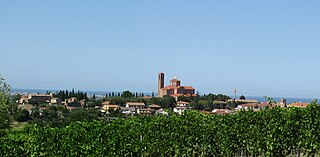
Coriano is a comune in the province of Rimini. This town is known for being the town of the Motorcycle World Champion, in 250cc class, Marco Simoncelli.
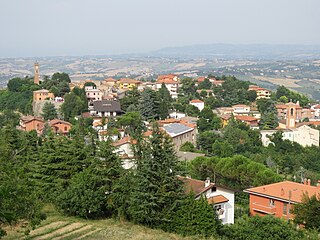
Montescudo is a frazione and former comune (municipality) in the Province of Rimini in the Italian region Emilia-Romagna, located about 120 kilometres (75 mi) southeast of Bologna and about 15 kilometres (9 mi) south of Rimini.

The Grand Hotel Rimini is a five-star hotel located in Rimini, in the region of Emilia-Romagna, northern Italy. As one of Rimini's most well-known buildings, the hotel is known for its elegance, classic style, and association with filmmaker Federico Fellini.

The Bridge of Tiberius, historically also the Bridge of Augustus or the Bridge of Saint Julian, is a Roman bridge in Rimini, in the region of Emilia-Romagna, northern Italy.
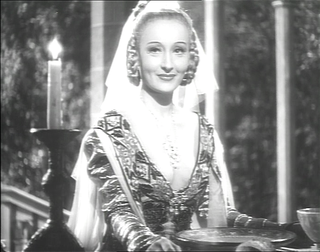
Clara Calamai was an Italian actress.
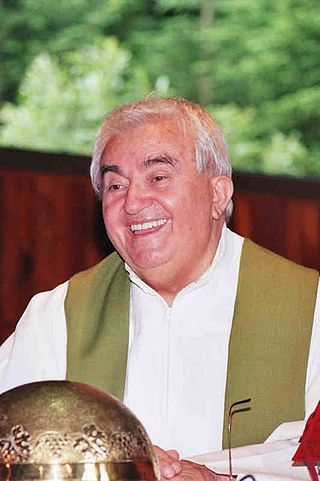
Oreste Benzi was an Italian Catholic priest and founder of the Pope John XXIII Community. Benzi championed the rights of the individual and founded his association to aid teenagers in their lives and their path to Jesus Christ while also striving to evangelize to those including the destitute.

The Battle of Rimini took place between 13 and 21 September 1944 during Operation Olive, the main Allied offensive on the Gothic Line in August and September 1944, part of the Italian Campaign in the Second World War. Rimini, a city on Italy's Adriatic coast, anchored the Rimini Line, a German defensive line which was the third such line of the Gothic Line defences.
Count Renato Zavagli Ricciardelli delle Caminate, professionally known as René Gruau was a fashion illustrator whose exaggerated portrayal of fashion design through painting has had a lasting effect on the fashion industry. Because of Gruau's inherent skills and creativity, he contributed to a change in the entire fashion industry through the new pictures that represented the already popular designs created by designers in the industry. The benefits, including economic stimulation and enhancement of advertising are still present in the industry today via a new way of fashion illustration, fashion photography. Gruau became one of the best known and favorite artists of the haute couture world during the 1940s and 50s working with Femina, Marie Claire, L'Officiel, L'Album Du Figaro and an assortment of "high-style" magazines. Gruau's artwork is recognized and commended internationally in some of Paris and Italy's most prestigious art museums including the Louvre in Paris and the Blank in Italy. In addition to his international fame and recognition, "Gruau's artwork is known for its timeless and enduring style".

Sandra Maria Assunta Sabattini was an Italian diarist, medical student, and member of the Pope John XXIII Community, who was beatified by the Catholic Church on 24 October 2021.

The Museo della Città is the civic museum located in the former Jesuit convent on Via Luigi Tonini #1 of the city of Rimini, in the region of Emilia-Romagna, Italy. It rises adjacent to Chiesa del Suffragio, and a modern structure built to enclose the ruins of an ancient Roman Domus, or house.
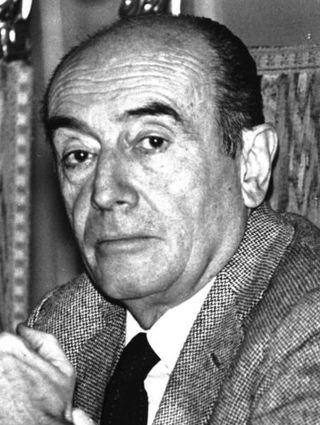
Renato Zangheri was an Italian politician, who was Mayor of Bologna from 1970 to 1983 and Member of the Chamber of Deputies from 1893 to 1992.

Sergio Wolmar Zavoli was an Italian sports and documentary journalist and politician.
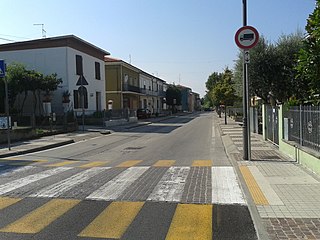
San Vito is a town in Emilia-Romagna, northern Italy. The town is divided between the comuni of Rimini and Santarcangelo di Romagna, both in the Province of Rimini, with a northern part in San Mauro Pascoli, in the Province of Forlì-Cesena. Culturally, the town is closest to Santarcangelo.
The Villa des Vergers is a countryside villa in San Lorenzo in Correggiano, a frazione of Rimini, in the region of Emilia-Romagna, northern Italy. Dating to the 17th century, the villa was purchased by Adolphe Noël des Vergers in 1843, and substantially redesigned in 1879 by Arthur-Stanislas Diet. Between 1938 and 1946, it was owned by Mario Ruspoli, 2nd Prince of Poggio Suasa, who employed Pietro Porcinai to design the villa's gardens. The villa was used as a military headquarters by German forces in the Second World War, and has since been owned by a series of local entrepreneurs.

The Coriano Ridge War Cemetery, locally known as the English War Cemetery, is a Commonwealth military cemetery in Coriano, in the region of Emilia-Romagna, northern Italy, for Allied soldiers who died in the Second World War during the Allied advance through the Valconca and the battles of Coriano and Rimini.




















